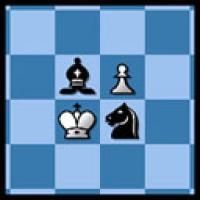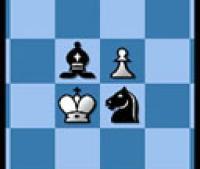
Chess Gear: New York Times Deluxe Edition Touch Screen Chess
A friend of mine, let's call him "Jay," recently bought a handheld chess computer because he wanted to practice his chess skill without being tethered to his PC. He placed an order with Barnes and Nobles for the New York Times Deluxe Edition Touch Screen Chess, and when it arrived, he immediately handed it to me and said, "figure out how to use this thing and teach me how to use it when we get together for our next chess game." That was on a Friday, and our next chess game would be on Sunday morning. "No problem!" I said. It was short notice, but, of course, I couldn't pass up the opportunity to fiddle around with a new gizmo.
This unit is fairly large as hand held computers go. It's about the size of your average day-planner, and much bigger than a cellphone or a PDA, so it's not something you can carrying around in your pocket. The construction seems reasonably solid, but every surface on this gadget is nice and shiny which makes it the ideal greasy fingerprint magnet. The touch screen itself is glossy, and it is resistive rather than capacitive so while you can use it with your fingers, it is best used with the provided stylus which has the added benefit of preventing the screen from accruing layers of fingerprints. Of course, Jay needs to be alert to the possibility of losing the stylus as the computer ships with only one of the little buggers, and there doesn't seem to be any way to order a new stylus.
The next thing I noticed was the screen resolution. I don't know what the actual pixel count is, but suffice it to say that the resolution is very low. I would say it's about on par with the Commodore VIC-20 I used as a 15 year old, and that's being rather generous. The words displayed on the screen are quite readable, but differentiating the types of chess men on the board is exceedingly difficult. I mean, really difficult. Let me say that one more time: incredibly difficult. No doubt once Jay has used it enough it won't be such a hassle to tell one piece from another, but that assumes he'll stick with it long enough for that to happen.
So that's the first usability problem. But wait! There's more! If you are a gearhead at all, you've probably come across a gadget that has operator overload. There are gizmos in the world with interfaces that are often termed as "modal." The general idea with these things is the intention of simplifying the user interface by limiting the number of knobs and buttons on the interface. The sad side effect of this so-called simplification is often the overloading of each button with several functions. So, the mode selected for the gadget determines the action produced by each control.
Let me give you an example. Suppose you have an AM car radio which has one mode dial which selects between three modes: A, B and C. Also suppose that there are two buttons: button M and button N. When the mode dial is set to A, pressing button M lowers the volume on the radio while pressing the N button raises the volume. That sounds just fine, right? Now suppose that when the mode dial is set to B, the M button changes the selected frequency to the next lowest programmed radio station, while the N button moves the radio to the next highest programmed station. So far so good. Now, suppose the designers of the car decided to save some space and expense, and they didn't want to add on/off buttons for the windshield wipers. So, what did they do? You got it! They overloaded the M and N radio buttons once again, so that now, when the mode button is set to C, the M button starts the wipers and the N button stops the wipers! Genius!
You get my point, right? This whole car radio setup is impossible to use intuitively, it probably makes the user manual almost incomprehensible, and that's the situation for the controls on the Touch Screen Chess.
It gets even better. I'll pick on the levels of difficulty next. To be fair, the Excalibur Touch Screen Chess does have a wide variety of playing levels which not only provide differing levels of play, but different types of timed games. However, the naming convention for these levels is opaque at best. I defy you to tell me what level is denoted by the label "FH230" without having used this machine previously and without resorting to the manual.
Screw that, I'll even let you use the manual if you think that will help.
This thing comes with a certain amount of sound effects. It can speak the moves to you as you play them, and it will give you strange noises when moving the pieces. I think the noise it makes when you move a pawn is supposed to resemble the sound of marching feet, but that's just a guess and I wouldn't bet money on it. But, again, the sound chip this thing uses must have come straight out of of 1989 because it sounds just like those horrible noises made by the PC speaker on my old 286.
I could grind on about the awful user interface, but let's just say the entire experience is whack.
One of the reasons for Jay's purchase was the inclusion of chess puzzles from the New York Times newspaper. There are, indeed, a substantial number of such problems, ranging from mating problems to problems of winning material, and even some problems regarding best moves in losing positions.
Touch Screen Chess will let you play against the computer, it will let two human players face off against each other, and it can play against itself while you watch.
There are many things it doesn't do, however. Although it will save your current game so that you can finish it up at a later date, it only saves the position so there is no way to replay any of your games. Jay was sort of hoping that he could use the Touch Screen Chess to record our OTB games, but, sadly, that is not possible. There is no way to exchange data between a computer and the handheld game. It doesn't have a power chord, so there's no chance of running it when the batteries are out of juice. On the other hand, this game uses good old AAA batteries, so it's no big thang to buy some more or use some rechargeables if you have them handy.
It's difficult to say something positive about the New York Times Deluxe Edition Touch Screen Chess. I suppose the best that can be said is that it will, in fact, let you play chess wherever it is you happen to be, assuming that it's awkward dimensions don't prevent you from carting it around with you.
The cost of this thing is about 80 bucks. Part of me wants to say that I shouldn't really expect anything fancy for that price, and that may be true, but mostly I think Jay got ripped off. My advice to my readers is that if you even have the slightest idea of purchasing the New York Times Deluxe Edition Touch Screen Chess, make sure you give it a go before you make a purchase. Jay can probably send this thing back if he decides it's unusable, but you know how much of a hassle that sort of thing can be.
There you have it. I'm Stick, your resident wordslinger, and I'll see y'all out there on the gridiron!

